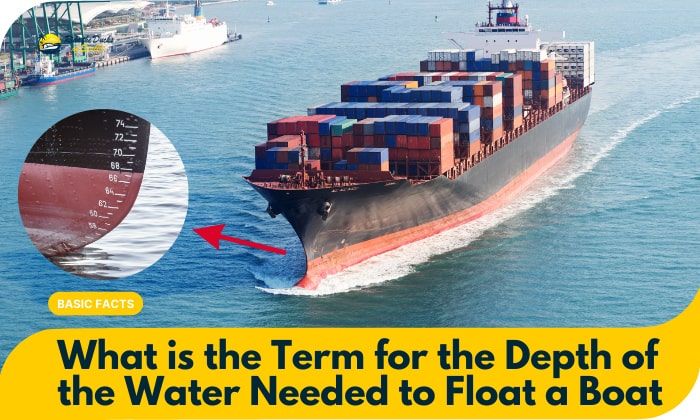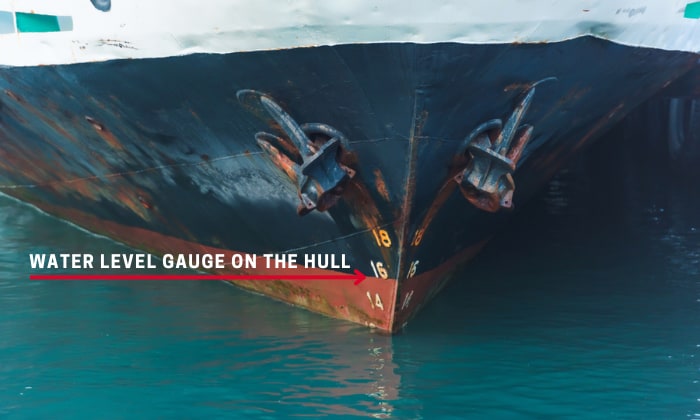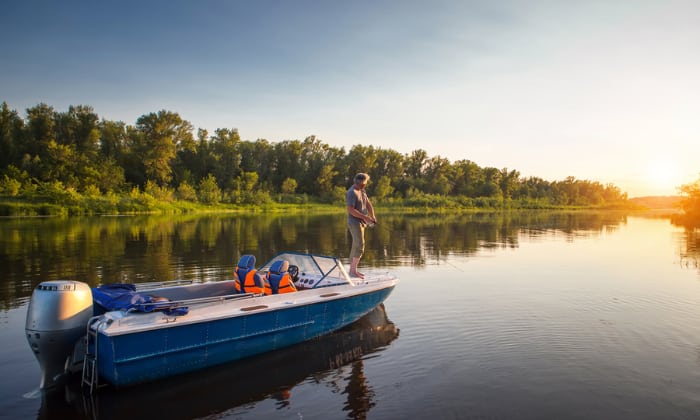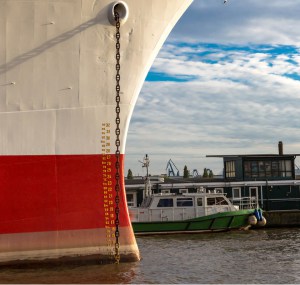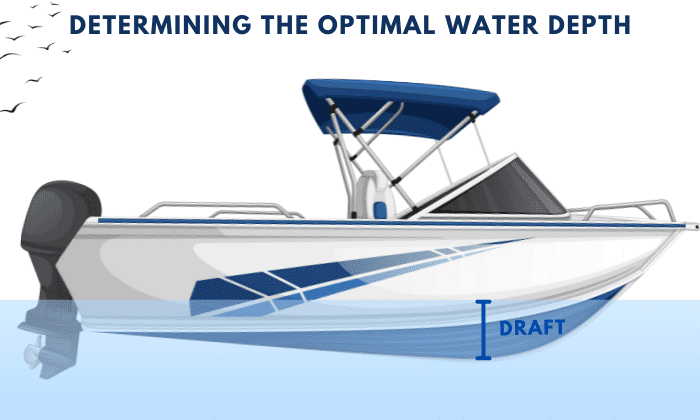“Draft” or “draught” answers the question, “What is the term for the depth of the water needed to float a boat?” Boat owners, operators, and crew must know “draught” or “draw” by heart because it helps them decide if they can maneuver their watercraft on a given body of water.
Please keep reading to learn about the minimum water depth for boat, including its importance and the average drafts of different vessels.
Table of Contents
An Overview of a Boat’s “Draft”
“Draft” (also called “draught” or “draw”) is one of the many boat measurement terms operators and owners of watercraft must know. This measurement describes the distance between the boat’s keel (the hull’s bottom most part) and its waterline.
To simplify, a boat’s draft reflects the minimum water depth the watercraft needs to run. In other words, how deep or shallow you can pilot a watercraft hinges on the vessel’s draft rating.
- For example, suppose you have a boat with a 16-inch draft, and you’re navigating a two-foot-deep waterway. In that case, you can certainly keep your boat above water without worrying about getting stranded.
- On the other hand, if you push your vessel with a three-foot draft in the same waterway, you risk damaging your hull by running aground.
Canals and channels observe and implement strict rules on minimum drafts. Watercraft cannot pass through such waterways if the draft is greater than the water depth.
It’s worth pointing out that a boat’s draft is variable. Adding more weight to the vessel will invariably push it deeper into the water, thus increasing the keel-to-waterline distance.
Hence, if there’s a minimum keel-to-waterline distance—the shallowest water depth the vessel can go, there’s also a maximum draft—the deepest the boat can be in the water without getting swamped.
Interestingly, some folks confuse draft with the depth of a boat. The latter describes the distance between the keel’s topmost section to the deck beam’s topmost side. Meanwhile, the draft is the keel-to-waterline distance.
The Average Boat Draft
A boat operator’s knowledge of “draft” allows him to float a boat clear of the bottom, eliminating the risk of running aground. Unfortunately, no average “draft” exists across all types of vessels.
However, a flat-bottom watercraft can have a 4- to 6-inch draft, allowing it to navigate marshes, swamps, and shallow inland waterways. Meanwhile, an ultra-large container vessel can have a draft of at least 49.9 feet, deeper than the USS Gerald R. Ford aircraft carrier (39 feet).
So, on average, vessel drafts range from a few inches to several tens of feet.
Boat Floating Depth for Different Types of Boats
| Boat Type | Minimum Water Depth |
| Bass boats | 8 to 11 inches |
| Bay boats | 10 to 14 inches |
| Catamarans | 2 to 4 feet |
| Coastal cruising sailboats | 3 to 4 feet |
| Daysailers | 3 to 5 feet |
| Dinghy | A few inches |
| Jon boat | Less than 12 inches |
| Motor yacht cruisers | 1 to 4 feet |
| Pontoon boats | 10 to 12 inches |
| Sailboat cruisers | 4 to 7 feet |
| Skiffs | 3 to 4 inches |
| Trawlers | At least 8 feet |
You might be surprised that pontoon boats (a type of boat that floats above water) also have a “draft.” Although these vessels don’t have the conventional “keel” of one-hulled watercraft, their pontoons still have a bottommost section and waterline.
As a rule, small vessels have a shallow draft (several inches), while large watercraft have a deep draft (several feet).
Factors Affecting Boat Floating Depth
Two crucial factors influence a boat’s floating depth: weight and density. These parameters impact a watercraft’s buoyancy (the ability to stay afloat) and displacement (the amount of water the vessel moves out of the way).
1. Weight
Some watercraft (i.e., cruise liners, cargo ships, and military vessels) are heavier than others (i.e., bass boats, dinghies, and Jon boats), allowing them to move more water out of the way.
The increased displacement increases floating depth, raising the distance between the bottommost section and the waterline. To put it simply, the heavier the vessel, the deeper its draft will likely be.
It’s worth mentioning that the “drafts” of boats are approximations, reflecting a watercraft’s “dry weight” (without passengers, gear, fuel, and other items).
2. Density
Boats can have identical weights, but they can vary in buoyancy. One might float, while another might have its hull deeper into the water. So, it’s possible for a boat sit in the water while another vessel has more of its hull “submerged.”
Despite identical weights, a boat’s density accounts for such variances in floating depths. Some vessels are “denser” than others, submerging their lower sections deeper into the water and increasing their drafts.
Determining the Optimal Water Depth
As mentioned, manufacturers calculate their vessels’ draft ratings without fuel, empty water tanks, zero gear, and no passengers. Hence, boaters must adjust their expectations to navigate waterways without running aground or getting swamped.
To determine the optimal water depth, experts recommend considering the weights of various boat elements.
- Boaters must account for the weights of the fuel, gears, passengers, and other objects. These items can make the vessel heavier, increasing its flotation depth or draft.
- You can load everything (including people) in your boat and measure the distance between the waterline and the bottommost section.
For instance, the watercraft might have a draft rating of 15 inches. However, loading it for a trip increases its draft to 18 inches.
Make the 18-inch adjusted draft your reference in determining optimal water depth. You cannot maneuver your vessel in waters shallower than 18 inches.
Ensuring Safety and Performance
Here are some tips to ensure safety and performance, integrating your knowledge of boat draft.
- Create a “float plan” (your boating trip’s details) and give this to someone who will stay behind when you go boating.
- Know the boating location, especially for shallow sections and underwater obstacles.
- Learn how to analyze and interpret tidal occurrences because low tides can increase your chances of getting stranded.
- Install depth finders and similar technologies in your boat.
- Bring long poles to push your vessel in shallow waters.
- Adjust the outboard motor’s trim a little higher than usual when navigating shallow waters.
- Reduce your speed when treading shallow waters.
Frequently Asked Questions
Can a boat float in shallow water?
Any boat can float in shallow water, provided its draft is less than the depth of water. For example, a watercraft with a 10-inch draft can float in 12-inch-deep water, but a two-foot-draft vessel cannot.
Are there any regulations regarding boat flotation depth?
Yes, regulations about boat flotation depth exist. Title 33 of the Code of Federal Regulations: Navigation and Navigable Waters, under Part 183 (Boats and Associated Equipment) and subparts F to H (Flotation Requirements), guides boat manufacturers in designing flotation depth.
Conclusion
“What is the term for the depth of the water needed to float a boat?” Answering this question requires understanding what “draft” means among sailors. Seasoned mariners call it “draught,” while some call it “draw.”
Regardless of terminology, “draft” or “draught” reflects a watercraft’s ability to float on water, especially on shallow sections. Knowledge of this boating terminology can help you avoid running the watercraft aground and damaging the hull.

Ten years of enjoying countless trips on boats never made me love them any less! So I am here to put all those experiences into good use for other boaters who want to have a safe and fun trip with their friends and families.

